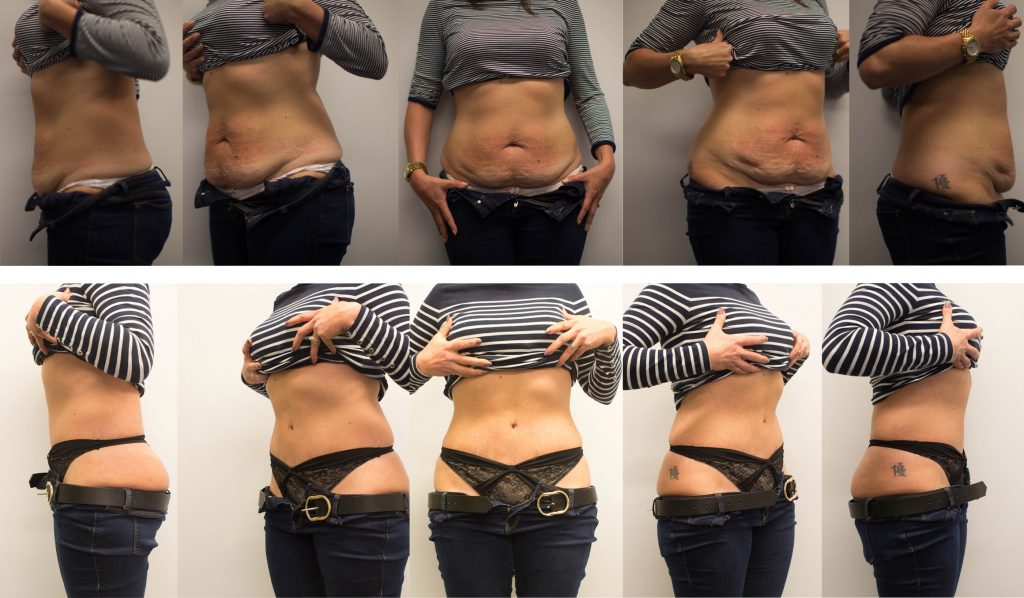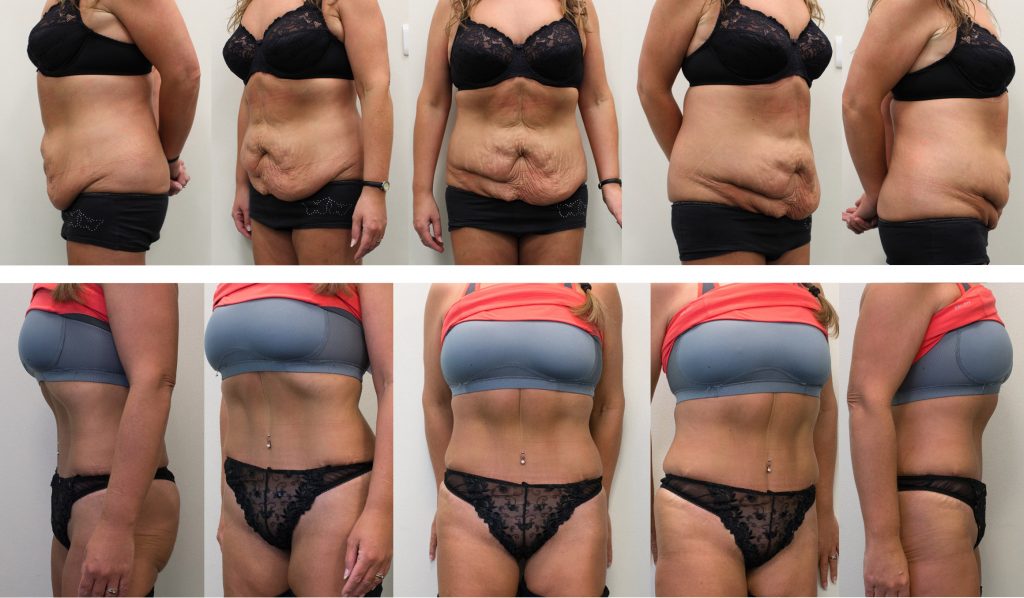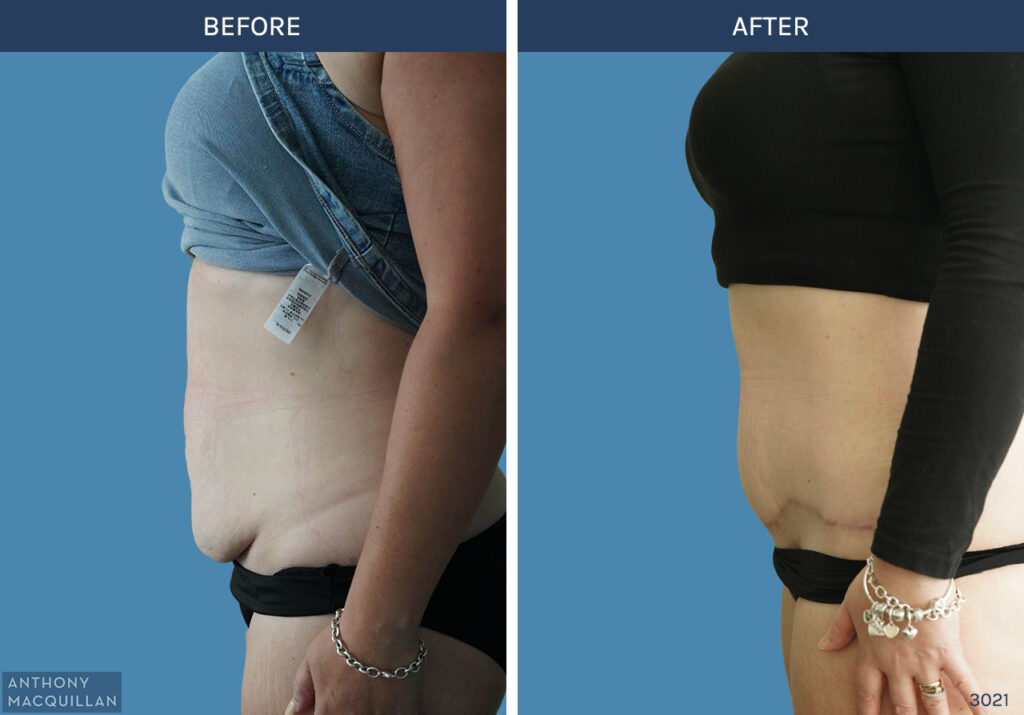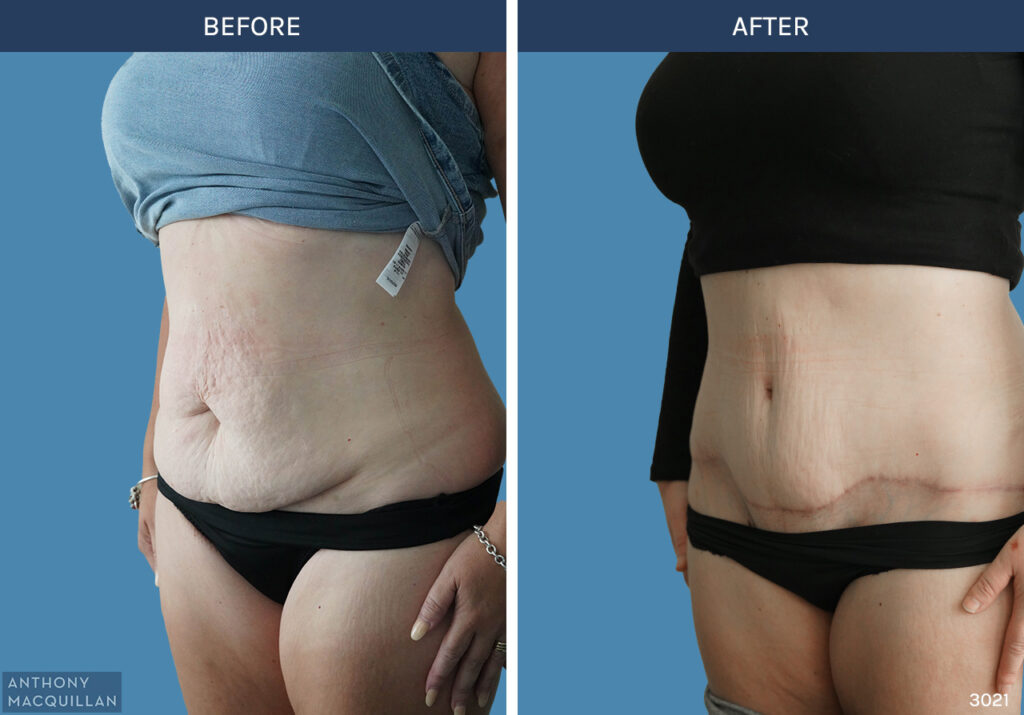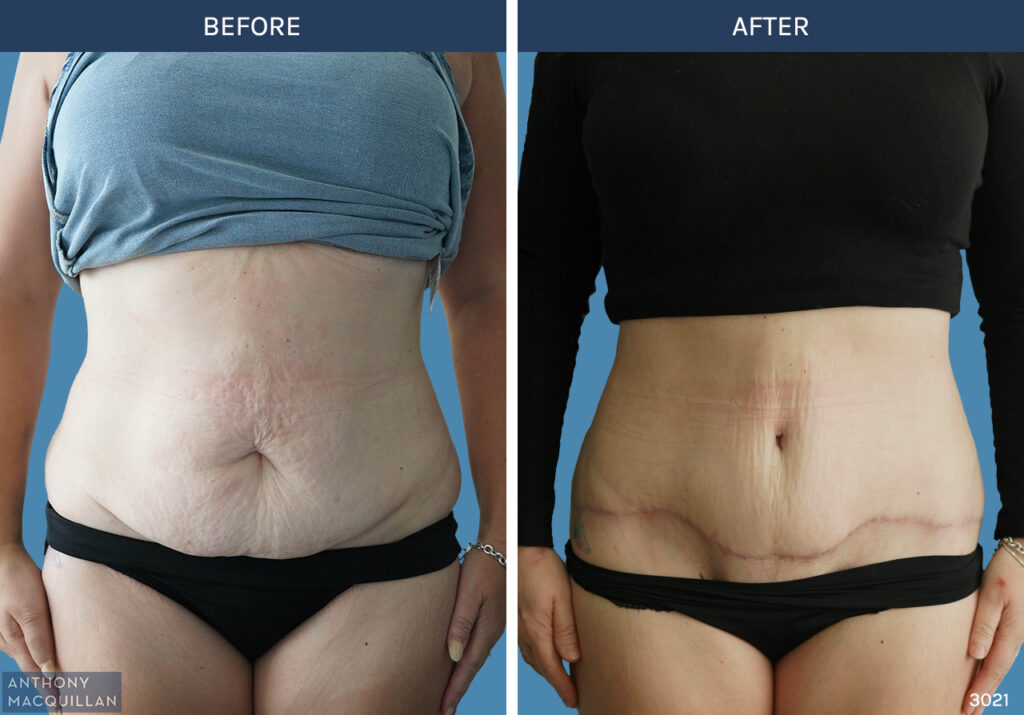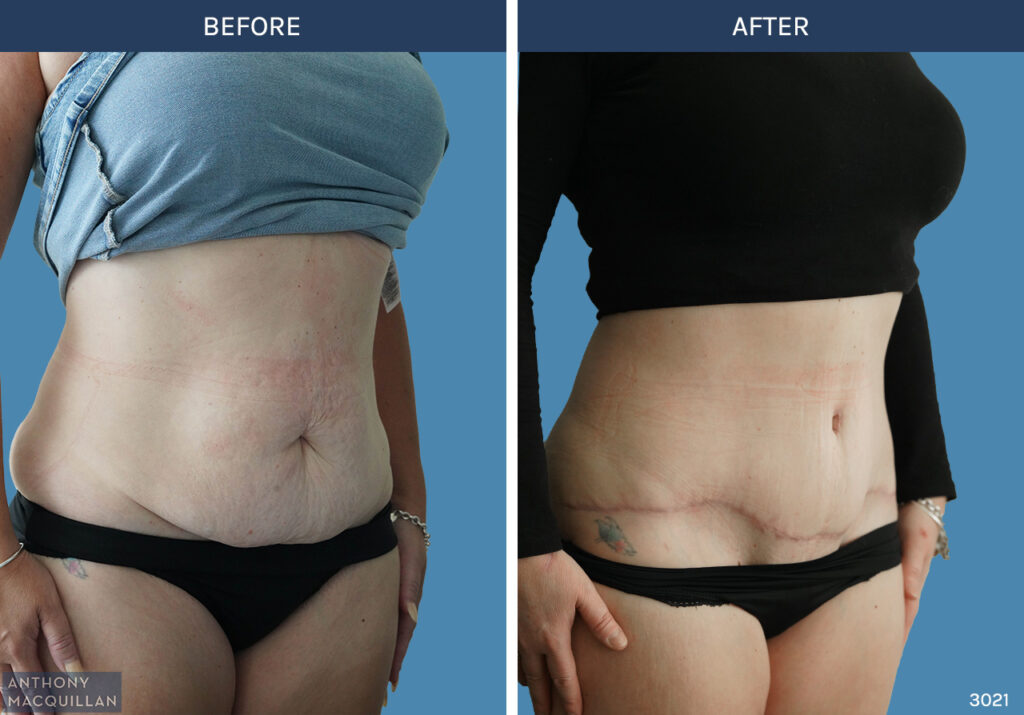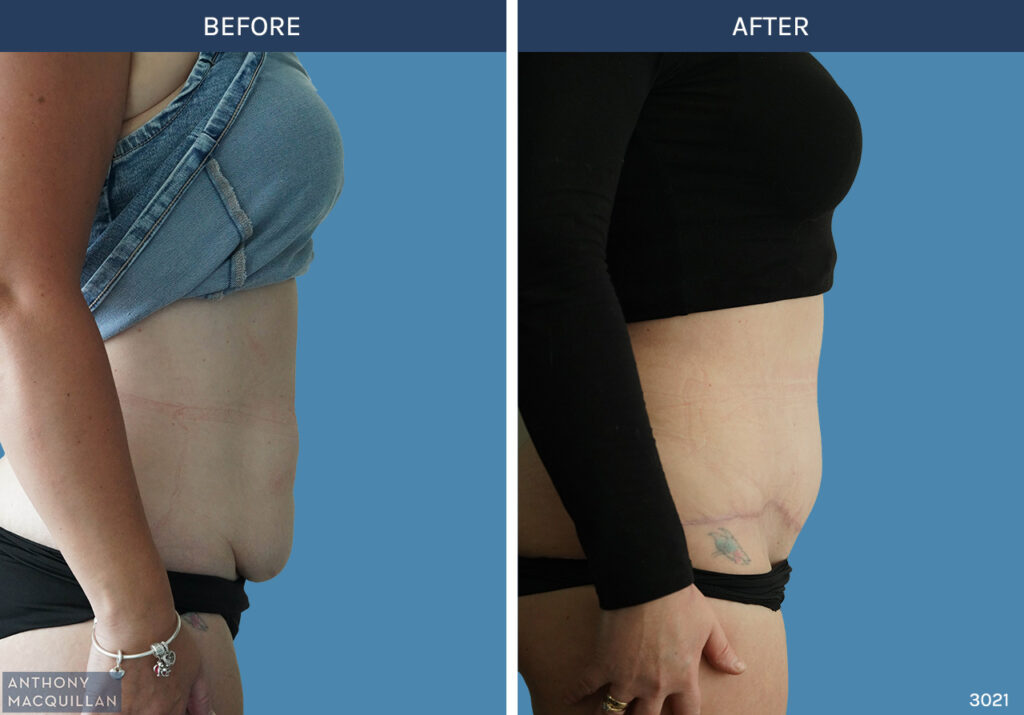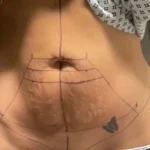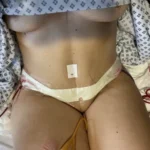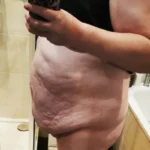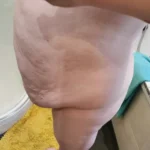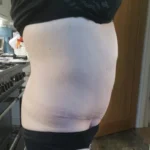A Tummy Tuck Surgery removes excess skin, tissue and stubborn pockets of fat from below the umbilicus (or tummy button).
Normal reasons for seeking a Tummy Tuck, medically known as an Abdominoplasty, are after a pregnancy or losing a lot of weight.
Abdominoplasty surgery can tighten your abdominal skin and can improve your waistline. It is sometimes combined with liposuction for additional tummy contour definition depending on the amount of tissue that needs to be removed.
Tummy Tuck is a popular procedure, that involves a short stay in hospital and you should be back to full activities by six weeks following surgery.
To explore how a Tummy Tuck procedure can help you achieve the figure you desire, we invite you to schedule a consultation with Anthony today.
2 hours
General
1 to 2 nights
6 weeks
Swelling can last for several months, so final results are seen after 6 months.
Tummy Tuck Before & After Photos
Click to View PhotoClick to see 22 more sets of Abdominoplasty Before and After Photos
Who Needs an Abdominoplasty?
Abdominoplasty is a surgical procedure that can help improve the appearance and contour of your abdominal area. This procedure is particularly popular among those who have experienced significant weight loss, leading to excess, sagging skin, or women post-pregnancy who struggle with weakened abdominal muscles and stretched skin.
It’s also an option for people who find that diet and exercise alone are insufficient to correct the abdominal area’s appearance. Abdominoplasty is not a one-size-fits-all solution; it’s best suited for individuals who are in good overall health, have realistic expectations, and understand that it is not a substitute for weight loss or an appropriate exercise program.
Benefits and Limitations of Tummy Tuck Surgery
Tummy Tuck surgery offers a solution for those struggling to eliminate stubborn abdominal fat pockets, providing a smoother contour through targeted liposuction. However, it’s essential to understand both the benefits and limitations of this procedure:
Benefit
Smoother Abdomen: Tummy Tuck surgery effectively removes lingering fat deposits that resist traditional methods like diet and exercise, resulting in a more streamlined abdomen.
Limitation
Weight Management Responsibility: While Tummy Tuck surgery can restore your body to its pre-pregnancy or desired state, maintaining results requires a commitment to a stable weight. Significant weight gain after the procedure can compromise outcomes, emphasizing the importance of a healthy lifestyle post-surgery.
Benefit
Strengthened Stomach Muscles This procedure not only addresses excess skin and fat but also repairs weakened abdominal muscles often caused by weight fluctuations or pregnancy, restoring core strength and stability.
Limitation
Natural Muscle Definition Although a Tummy Tuck can enhance abdominal contours, achieving a sculpted six-pack requires additional efforts such as targeted exercise. However, many patients find the improved profile motivates them to adopt healthier habits.
Benefit
Elimination of Saggy Skin For individuals frustrated by loose, sagging skin that remains after weight loss, a Tummy Tuck provides a solution by trimming excess skin and revealing a more defined silhouette.
Limitation
Limited Stretch Mark Reduction While Tummy Tuck surgery can address stretch marks associated with excess skin removal, it may not eliminate those present on other areas of the abdomen or body.
For a comprehensive understanding of Tummy Tuck surgery and its potential impact on your body goals, we encourage you to schedule a consultation with us. During this session, we can discuss your specific concerns, desired outcomes, and address any questions you may have, empowering you to make an informed decision regarding abdominoplasty.
Different Types of Abdominoplasty
Mini Tummy Tuck
The Mini Abdominoplasty is ideal for those who have a small amount of excess skin and fat directly below the belly button.
This less invasive option involves a smaller incision and often has a quicker recovery time.
It does NOT include split abdominal muscle repair.
Full Tummy Tuck / Abdominoplasty
A Full Tummy Tuck /Abdominoplasty involves a traditional “hip to hip” incision along the bikini line to remove excess skin and tissues.
At the same time a Full Tummy Tuck involves performing internal muscle repair across the entire abdominal area, both above and below the belly button.
Extended Tummy Tuck / Abdominoplasty
An Extended Tummy Tuck / Abdominoplasty removes excess skin and fat from the abdomen and repairs any muscles that have become stretched, loose or torn (usually during pregnancy).
It is a more extensive variation of the Full Tummy Tuck as it is used for patients with significant excess skin around the flanks.
Through an incision above the pubic hairline that wraps around to the lower back, skin and fat are removed from the stomach and flank area.
FDL Tummy Tuck / Fleur de Lis Abdominoplasty
The Fleur-de-Lis Abdominoplasty, named after the flower it resembles is for patients who have significant loose drooping skin after massive weight loss.
This procedure is particularly suited for those with excess skin in both the vertical and horizontal dimensions of the abdomen.
It involves an inverted T-shaped incision.
Tummy Liposuction with Body Jet
Tummy Liposuction can help reduce stubborn pockets of fat and contour your abdomen. This can be a beneficial extra for Abdominoplasty surgery.
Body jet liposuction is a special type of Liposuction that uses a stream of pressurized water to loosen and detach stubborn pockets of fat.
Local or general anesthesia is used to reduce discomfort as the gentle flow of water helps preserve surrounding connective tissues during the removal of the fat cells.
Preserving this surrounding tissue can help reduce swelling and bruising while promoting faster healing.
About the Full Tummy Tuck Surgical Procedure
Tummy Tuck Surgery involves removal of an oval-shaped piece of skin from beneath the umbilicus (or tummy button).
The lower border of the incision runs from either hip to just above the pubic hair in the midline (where are C-section scar normally sits) and from either hip to just above the umbilicus for the upper border.
The skin and underlying fat contained within the incision borders is removed, and then the skin from above the umbilicus is lifted and pulled down so that it meets the lower edge of the incision. At the same time, the tummy muscles are tightened using sutures, improving the definition of the waistline.
How long does Tummy Tuck surgery take?
It takes between 2 to 3 hours and usually involves a one or two-night stay in hospital.
You will have drains in following the surgery (tubes to take away fluid that can accumulate beneath the skin), and these are normally taken out before discharge from hospital.
After surgery, you will be nursed with pillows beneath your knees to take any tension off the incisions. It’s important to make sure that you stay slightly bent over for the first week following surgery.
By the end of the first week, you will be starting to feel more active and can return to light activities.
Over the following four weeks, you will be able to increase your activity levels and by six weeks you should be able to resume your normal daily routine.
Tummy Tuck Recovery and Aftercare
We know what a tuck does, and how it’s the only real solution for body shapes that have undergone pregnancy and major weight loss.
We also know they can provide a massive boost to your confidence, mainly because clients have told us as much. And we’re fully aware that as well as making us look good on the outside, a tuck can do a lot of good on the inside too, restoring the position of the stomach muscles and nipping a lot of potential abdominal problems in the bud.
But it also needs to be stressed that the level of work involved in an Abdominoplasty procedure, both for the surgeon and the patient, is high. This is not a walk-in-walk-out procedure: a typical tuck involves a long incision, the trimming off of excess skin, the possible removal of fat, the possible moving of the stomach muscles back to their original position, and a lot of suturing.
Consequently, recovery time is long by aesthetic surgery standards: there will be up to 2 weeks where you will be expected to rest completely, and it can be up to 2 months before you’re fully back to normal.
And, during this time, you’ll discover just how much your stomach area is utilised during day-to-day routines. Talk to any of our patients and they’ll tell you that after all that, a tuck is still worth it, but we can’t stress this enough – don’t walk into this procedure without understanding.
Videos
How Much Is Tummy Tuck Surgery in the UK?
The total cost of Tummy Tuck Surgery in the UK depends on the type of procedure being performed. For example, a Tummy Tuck or Abdominoplasty can range from £6,500 to £20,000.
These prices are influenced by numerous factors including the surgeon’s training & experience, the complexity of the operation, the type of anaesthesia, the facility used and the post-op and follow-up care you receive. After your consultation, you will be given an estimate of the costs for a procedure tailored to your needs. It’s also important to ensure that all these necessary items are listed on the quote you receive.
FAQs
Find out more about your surgical journey
What must I know before having a Tummy Tuck?
There are 7 things you must know before you have Tummy Tuck surgery
A Tummy Tuck is an increasingly popular body reshaping procedure. Here, our Tummy Tuck expert covers all aspects of the Abdominoplasty procedure:
1. Expect a significant period of downtime
There’s no getting around it: a Tummy Tuck is a major surgical procedure and it will take weeks for you to heal. After all, we’re talking about a hip-to-hip incision, the repositioning of your stomach muscles and removal of fat and skin, so you should be fully prepared for two to three weeks of downtime.
2. Expect some pain and discomfort at first
Immediately after the procedure, you will experience sensations of fatigue, swelling and soreness. It is totally normal to have moderate pain during the healing process, but this will steadily improve.
3. Expect to need help & support early on
We can’t stress this enough: you’ve had a very invasive procedure on a part of the body that you’ve taken for granted all your life, and you’ll be surprised at what you won’t be able to do after the procedure, so it is essential that you allow yourself time to focus on rest and healing. If you think ‘rest and healing’ means ‘taking a week or so off work’, think again: Abdominoplasty patients will need assistance with household chores and children, and very strenuous physical activities are completely off the table for at least four to six weeks.
4. You need to be at a stable weight before your surgery
Why? Well, most surgeons will recommend that you are at or close to the ideal weight for your size and frame. This isn’t a carrot-and-stick thing or a way for the surgeon to make their own job easier. Weight fluctuations after the procedure can not only undo the shape achieved through your surgery, but it can also stretch the abdominal tissue, meaning you’ll have to undergo another procedure to reset your shape.
5. It will leave a permanent scar that will fade slowly over time
This will run along the horizontal incision line, stretching from hip to hip, right above the pubic bone and there may also be an incision around the belly button.
While the scar should heal well, it will never disappear completely. During your consultation, placement of the incision and how to ensure the best possible healing is discussed.
6. You may need surgical drains after the procedure
After surgery, surgical drains (tubes which remove blood and other fluids from a wound or incision) can be put in place to eliminate build-ups, keep swelling down and ensure the healing process goes as smoothly as possible.
You won’t have them in for long – they’re usually removed after a week or so. You’ll need to keep an eye on them and ensure they don’t get knocked out.
Your cosmetic surgeon will take you through whether you’ll need them and how to care for them.
7. Full healing can take up to a year
The timescale of post-op Abdominoplasty is not swift. Over the first several weeks, you’ll experience bruising, stiffness and swelling.
This will resolve over the first four to six weeks, and you’ll be able to visualise your results. However, there can still be residual swelling for six months or longer and it can take a full year before the complete results of surgery can be seen.
Should you add Liposuction to your Tummy Tuck?
Many people assume that a Tummy Tuck and a Liposuction procedure are one and the same, but they aren’t.
A standard Tummy Tuck procedure is geared towards people who have lost an excessive amount of weight or want to restore their pre-pregnancy shape. It mainly addresses saggy skin and weakened muscles.
While Liposuctions main role is to remove fat. If you want to tighten your stomach muscles, restore your natural, taut shape and remove fat, there isn’t an all-in-one treatment: if you want all three results adding Liposuction to your procedure is essential. It’s known in the trade as a lipo-abdominoplasty, and it’s easier to perform than you think.
What happens during liposuction? The liposuction procedure is simple enough: a small incision is made in the targeted area, and a cannula – a hollow metal tube, attached to a suction pump – is inserted. Then, the requisite amounts of fat cells are sucked out, in order to achieve a smoother and more even appearance. The incisions are then sutured.
There’s a general misconception about liposuction: that it’s a procedure only to be used in cases of extreme obesity, or as a vanity project for people who want to suck away weight without putting in the effort themselves. However, lipo typically isn’t suitable for patients that are extremely overweight and should never be seen as a weight loss procedure. It is a procedure designed to improve body shape and remove small pockets of fat that are resistant to diet and exercise.
There are two main benefits to having both procedures done at the same time. Firstly, your cosmetic surgeon can do one treatment while performing the other without having to do much else, meaning all your issues can be dealt with in one procedure – without complicating your recovery period. In actual fact, when you have lipo too, the practitioner can eliminate the need for post-surgical drains by deploying a layered suture process, which can actually speed up the recovery process.
When can I start exercising after a Tummy Tuck?
The short answer, according to the medical community is: it depends.
There are general guidelines, but you should listen to your plastic surgeon as they will take into account your starting point in terms of your general health and fitness levels and also how extensive surgery was.
Here’s a general guide to what you can – and can’t – do in the gym or in the park as you recover from Tummy Tuck surgery.
Remember, this is a general guide, and should be treated as such. Your cosmetic surgeon – the person who has gone in there and examined your abdomen – knows what has been done to you, and how far down the line you are to complete recovery.
Exercising immediately afterwards
All reputable surgeons agree that complete rest over the first 2 weeks following surgery is essential, as you undergo a period called ‘wound healing’.
It’s not like you’ll want to exert yourself, whether you want to or not: you’ll be undergoing a degree of discomfort, soreness and fatigue in the first few weeks.
However, you will be expected to ‘get back on the horse’ within the first 24 hours after treatment by getting up, walking around, and keeping mobile. Nothing too strenuous, but walking helps to improve circulation, therefore decreasing the chance of risks developing, such as a blood clot. Improved circulation also benefits the body’s natural healing process.
If you feel you have to bend forward to avoid further discomfort, don’t panic: that’s an entirely natural response. You are strongly advised to avoid heavy lifting, intense cardio activities, and anything which will put pressure on your abs during this period, especially if you’ve had your stomach muscles tightened – the tissues around the muscles require time to heal.
Exercising a month after
After four to six weeks, the vast majority of the soreness and fatigue will have disappeared, so it’s time to hit the gym again, right?
Wrong, according to most surgeons. Even if you were active before your procedure, you still might not be ready to get stuck into the weights – and at best, and if your surgeon has approved it, you will be encouraged to slowly dip a toe into mid-level activities such as yoga, jogging, swimming and cycling. Again, you’re strongly advised to avoid heavy lifting and abdominal exercises.
Exercising three months after
After twelve weeks, most clients will be ready to mix abdominal exercises and intense weight training into their exercise regime, because your core stomach muscles will finally be ready to take on the demands of heavy exercise.
You’ll be advised to start these exercises gradually, and to listen to your body at all times, gradually rebuilding your endurance levels to ensure that you can transition into your pre-surgery exercise levels as smoothly – and safely – as possible.
Do I need to lose weight before Tummy Tuck surgery?
A Tummy Tuck is not a substitute for diet and exercise.
You should have reached your ideal target weight (and be static at this weight) prior to having surgery as any further weight loss following surgery may result in more loose skin, compromising your aesthetic result.
A BMI of less than 32 is recommended for optimal aesthetic results.
What happens to my belly button?
Your umbilicus and belly button are usually relocated and recreated during the Tummy Tuck surgery.
Ask Anthony to explain the process, where it will be positioned and how it works.
What are the types of Tummy Tuck procedures?
Tummy Tuck or Abdominoplasty procedures come in a variety of types to cater to different needs and aesthetic goals.
- Mini Tummy Tuck / Abdominoplasty
- Full Tummy Tuck / Abdominoplasty with split muscle repair
- Extended Tummy Tuck / Abdominoplasty
- Circumferential Abdominoplasty or 360 Abdo
- Fleur De Lis Abdominoplasty
- Tummy Liposuction with Body Jet
Each type of Tummy Tuck has its specific indications, benefits, and recovery processes, and the choice largely depends on the individual’s unique body shape and desired outcome.
Should I consider a Mini Tummy Tuck?
What is a Mini Tummy Tuck?
If you feel you really need to do something about the shape and state of your abdomen area, you probably already know what a tuck is and what it can do. You might also be aware of – and tempted by – a Mini Tummy Tuck. After all, it sounds like a simpler (and possibly cheaper) procedure, and it is.
But there are some things that a Mini Tuck can’t do. To ensure you’re completely satisfied by your experience, it’s essential to get the procedure that meets your needs best.
What can it do… and what can’t it achieve?
Essentially, a Mini Tuck involves a smaller incision and a less comprehensive overhaul of the treated area. The extra skin and fat under the navel are addressed, without changing the location of the belly button. It’s a quicker operation, involves less downtime, the recovery period is shorter, and – because the incision is smaller – it leaves less scarring.
A Mini Tuck doesn’t repair the muscles of your abdominal walls, which may have been damaged by carrying extra weight, as well as removing any excess skin located further up the abdomen.
This is important to note because, after pregnancy or substantial weight gain and loss, previously taut and perfectly positioned abdominal muscles can loosen and weaken and sometimes they can even separate from each other. No matter how active you are in the gym, it’s usually impossible to put ab muscles back to where they belong without a little surgical help.
This aspect of the tuck is just as important as the skin and fat-removal element, and to skip it in order to save money and have a shorter scar could leave you dissatisfied with your results.
Am I suitable for a Mini Tummy Tuck?
If you have a minimal amount of excess skin and your abdominal wall is still strong, you may be a suitable candidate for a Mini Tummy Tuck.
If you’ve undergone pregnancy – or have been carrying excess weight for some time – there is a possibility that your ab walls are not strong enough and a Mini Tuck will not do the job you’ll want it to.
Obviously, it can be difficult to work out for yourself how strong (or otherwise) your abdominal muscles are, so it makes sense to book yourself in for a consultation which includes a full physical assessment and the opportunity to discuss your goals and aims with an experienced practitioner who can work with you to select and perform the procedure which suits you best. There’s nothing wrong with a Mini Tuck and for certain people, they can really work – but they’re not for everyone.
Tummy Tuck Surgery or Tummy Liposuction - What's better?
If you want a flatter stomach, you probably know there are two main options: Liposuction or a Tummy Tuck. However, it’s worth bearing in mind that these are two very different procedures and they do separate jobs. Choosing the best procedure for you depends on your individual concerns and expectations from surgery.
Understanding the difference between Liposuction and Tummy Tuck Surgery
Liposuction is an invasive procedure that sucks out excess fat, permanently removing it from the body and producing a more toned physique.
A Tummy Tuck, on the other hand, addresses the excess skin that hangs in folds after major weight loss by trimming some of it away and suturing what’s left – along with a strengthening of the abdominal wall muscles and repositioning of the belly button if required.
Who are they most suitable for?
A Tummy Tuck is the perfect solution for people who have carried excess weight for a period of time (including during pregnancy) and want to restore their original look and shape.
Liposuction is suited for people with areas of excess fat they want permanently removed, but still have good skin elasticity.
Which treatment is best for you?
If you want to drastically and permanently reduce body fat in a particular area of the face or body, liposuction is your best option. However, if you have lost weight – be it through diet, exercise, or post-pregnancy, and you don’t like how your abdomen area now appears, a Tummy Tuck is often the only way to achieve a flatter, more toned abdomen.
Bear in mind these two procedures are not exclusive to one another: in more cases than you think, elements of one are deployed in the other.
If you’re still unsure about which procedure would suit your needs best, it makes sense to book a consultation with us at your earliest convenience, so we can discuss your options.
What are the Risks and Potential Complications of a Tummy Tuck?
There’s always a risk in any surgical procedure and the more complicated the procedure, the greater the risk – but the combination of a skilled, professional surgeon and a fully-informed and aware patient is the best defence against any complications before and after a procedure.
Risks include:
- Bleeding
- Infection
- Wound healing problems
- Post-op fluid collections
- Blood clots in the legs (deep vein thrombosis or DVT)
- Clots developing in the lungs (pulmonary embolism)
Again, it needs to be stressed that all these risks are part and parcel of a typical surgical procedure, and great steps are always taken by our practice to avoid them. You will be fully instructed about the procedures you’ll need to take before and after surgery to make sure they don’t happen.
What can I do to avoid complications?
If you are in good shape, reasonably healthy, have normal blood pressure and are a non-smoker (or have given up smoking four weeks before the procedure), the risk of complications is very low. We will review your medical history during your consultation. In certain circumstances, you will be advised to visit your GP and get an all-clear from them.
Medical References about Tummy Tuck Surgery
- Tummy tuck – Mayo Clinic
- ‘Tummy Tuck’ Complications—Study Looks at Rates and Risk Factors
- Clinical Evaluation of 310 Abdominoplasties and Measurement of Scar Level
- Post-Bariatric Plastic Surgery: Abdominoplasty, the State of the Art in Body Contouring
- Comparison of Aesthetic Quality of the Final Scar in Abdominoplasty with Conventional and Mini Inverted t-Scar
Reviews
Patient satisfaction is the top priority for Anthony. You can find how patients feel about his work below.
After having 2 children by c-section over 10 years ago I had been left with a overhang. Over the years I have lost weight and the overhang has got considerably worse to the point it could be seen through my clothing. This made me very conscious, I’m a person who always wanted to look my best so would therefore look after myself and exercise to try to get rid of the overhang. Whatever I did it would not go. Over the years it started to get to me, eventually I made the
decision to have a tummy tuck. I done lots of research to find the right surgeon for me. Upon my initial consultation with Mr MacQuillan he immediately made me feel comfortable and at ease, he was very understanding about my overhang and took on board all of my issues. He advised that no amount of exercise would solve my overhang problem. He thoroughly explained the operation, pros and cons, and possibilities of complications. At no point did I feel pressurised. After a second consultation with Mr MacQuillan and pre surgery clinic with specialist nurse Michelle I set the date for 13th December 2021. Day of surgery arrived felt very nervous, got seen by Anthony and his anethetist who made me feel a bit at ease. Post surgery I stayed in for 2 nights, the nurses that looked after me were wonderful, could not do enough for me.
The first week was uncomfortable but not too painful, was expecting it to be a lot worse after reading a lot of reviews online, maybe I was lucky. Went back to work after 3 weeks and was also driving. Have seen Anthony several times now since surgery where he ha said everything is as expected and looking great. I am now 4 months post surgery back to running and exercising regularly, slight numbness it was told to expect that for up to a year.
This operation has totally changed by life, I no longer feel the need to worry that my overhang can been seen through my clothes. I have since been on holiday wear I wore a bikini without feeling self conscious and happily walked along the beach without covering up.
Anthony is a very special person, kind, genuine, authentic, and personable. Would definitely recommend anyone thinking of having a tummy tuck to go for it,
but do your research to find a surgeon you feel comfortable with and has a good background and reputation.
Also need to mention Amanda, Anthony’s medical secretary who each time I spoke with on the phone was very patient and easy to talk to. Also Michelle the specialist nurse who I saw on several occasions was lovely and attentive.


Wow! that’s all I can say about Anthony, I’m so happy I chose to have my tummy tuck surgery with him. He has changed my life from the initial consultation in March to surgery in July when the hospital opened again for operations Anthony & Lucy have been amazing! Having had 2 previous incisional hernia surgeries in the last couple of years, I was left with a very disfigured tummy Anthony reassured me that he could help and he didn’t disappoint! I’m so overwhelmed with the outcome he is kind, compassionate, and honest I would highly recommend the Only You clinic in Newport. Aftercare is second to none with nothing too much trouble. If you are thinking of cosmetic surgery book an appointment and you wont be disappointed. Thank you from the bottom of my heart Anthony x


After researching
abdominoplasty for 11 years since having my first child I finally decided that this was the right time to take the plunge. I’d finished having children and was at a stable body weight that I was happy with, other than my saggy apron belly. I chose Anthony MacQuillan because his chosen specialty was nerve trauma. This told me that he would take extra care. I wasn’t wrong.
From the initial call to his secretary Amanda, to meeting Anthony and his nurse Michelle I felt at ease, all my questions were answered fully and I was excited to proceed with the surgery.
I had a full abdominoplasty with diastasis recti repair.
I am now 8 weeks post op and my results are fantastic. Anthony is a magician. I look like I did in my teens. I’m thrilled with my results.
I can’t recommend Anthony and his team enough!
I have already given his details to all of my friends.


I have just been to see Anthony MacQuillan today for my six week follow up appointment. Six weeks ago, Anthony performed an abdominoplasty (tummy tuck), repairing my separated abdominal muscles, removing my wobbly mum tum and liposuction following two pregnancies.
My last pregnancy was 19 years ago so I have reluctantly lived with it since then!
The results are truly amazing. For the first time, I have a flat tummy and the confidence to wear what I like.
Mr MacQuillan thoroughly explained the procedure at my initial consultation, as well as the potential hazards. He has been professional, understanding and kind to me at all times. I have sailed through to this six week point with no medical problems at all. However, I would say that I massively underestimated the recovery process at home and I have been fairly incapacitated for the first four weeks. I only now feel able to start resuming my normal daily activities. Of course, someone else may find the recovery easier than I have.
I would not hesitate to recommend Anthony MacQuillan to anyone. He is a gifted surgeon in my opinion. He also appears to be very popular with the nursing staff at The Spire too! I guess that’s the best praise possible!
Thank you also to Anthony’s Secretary, Mandy. Always helpful and kind.
I hope this review helps someone to go ahead with their tummy tuck surgery dream with Mr MacQuillan – you won’t regret it!


Wow I cannot recommend Anthony enough. I have a very complex medical history previously. He made me feel so calm, at ease and more importantly he was honest and true with me from the moment I had my first consultation. I had my surgery back in May 2021. I had a fleur de lis and a mons pubic lift. He has been on hand for any minor mishaps.
Nothing has been a problem. I am having further surgery with him again this year in November. He did such an amazing job of my stomach and scar. I never expected my stomach to even look as good as it came out. He is so thoughtful and really listens. The staff at the hospital in Bath were all so caring and kind too.
They attended to me constantly. I was treated like a equal and not like you are on the NHS as an inconvenience. I recommend Anthony and his team now to everyone who asks me who did my surgery. I also share my story with others when I talk about my journey with cancer and bariatric surgery right up to plastic surgery. I always end it with the story of the man who restored my confidence and gave me my life back, Anthony MacQuillan. A 5 star surgeon and kind soul xx


I had been thinking of having a tummy tuck for a few years, I had researched and watched videos, I had lost weight and been to the gym to get fit but I wasn’t happy.
I met Anthony and Michelle (his nurse) at Circle Hospital Bath in April. I had just returned from a family holiday and was feeling pretty low. I had spent 3 weeks in LA refusing to let anyone take pictures of me because I didn’t like how I looked and knew this was sending wrong messages to my daughter. I had lost a lot of weight but my outsides were not reflecting the work or weight loss I had achieved.
Anthony was the first surgeon I had booked a consultation with and from the moment I walked into his office I felt at ease. He comes with a ready smile and willingness to explain everything. I left his office knowing that I was going to chose him as my surgeon. I met 2 other surgeons over the next week but neither of them gave me that same feeling of ease.
I met Anthony and Michelle one more time before my surgery, I exchanged emails with Mandy arranging the date for my Tummy Tuck and all ran smoothly. It was 6 weeks from first meeting to surgery and I felt in control at all times with regular communication.
The day of surgery came around and all went smoothly, I came out of surgery pleased with myself and thankful to Anthony and his team. He came and met with me to explain how it went and Michelle checked in on me regularly too. The team of nurses and health care assistants all made me as comfortable and pain free as possible. Unfortunately, for me, it turns out that my body doesn’t like surgery, the swelling I had was more than expected and I bruised terribly causing some concerns that I had a haematoma. I did have to have a second surgery but even that was made easy by the professionalism and care of all involved and Anthony met me post surgery to let me know that all had gone well. I never had a chance to feel scared, overwhelmed or worried – everyone was exactly where they needed to be and ensured I felt safe.
My post operative care was even better than I could have imagined, I saw Michelle a week post op for dressing changes and Anthony 2 weeks after that. All went well until 4 weeks post op when my body decided it was time to start spitting stitches and I ended up back at the hospital on my birthday of all days. Anthony came to see me at the hospital, removed the offending stitches and cleaned up what was a small infected area, I then saw him or Michelle on an almost weekly basis for the next few weeks.
From beginning to end I have been overwhelmed by the kindness and caring nature of Anthony and his team, I have always been able to contact him when I needed to and have seen him at short notice when required. His patience and professionalism has made the scary process of major surgery feel easy, so much so that I have already told him that I will be back for my next surgery when I decide what to have done first.
Thanks Anthony, you really have helped to change my life, I am once again a happy and confident woman ready to take on the world.


I had been thinking of having a tummy tuck for a few years, I had researched and watched videos, I had lost weight and been to the gym to get fit but I wasn’t happy.
I met Anthony and Michelle (his nurse) at Circle Hospital Bath in April. I had just returned from a family holiday and was feeling pretty low. I had spent 3 weeks in LA refusing to let anyone take pictures of me because I didn’t like how I looked and knew this was sending wrong messages to my daughter. I had lost a lot of weight but my outsides were not reflecting the work or weight loss I had achieved.
Anthony was the first surgeon I had booked a consultation with and from the moment I walked into his office I felt at ease. He comes with a ready smile and willingness to explain everything. I left his office knowing that I was going to chose him as my surgeon. I met 2 other surgeons over the next week but neither of them gave me that same feeling of ease.
I met Anthony and Michelle one more time before my surgery, I exchanged emails with Mandy arranging the date for my Tummy Tuck and all ran smoothly. It was 6 weeks from first meeting to surgery and I felt in control at all times with regular communication. The day of surgery came around and all went smoothly, I came out of surgery pleased with myself and thankful to Anthony and his team. He came and met with me to explain how it went and Michelle checked in on me regularly too. The team of nurses and health care assistants all made me as comfortable and pain free as possible. Unfortunately, for me, it turns out that my body doesn’t like surgery, the swelling I had was more than expected and I bruised terribly causing some concerns that I had a haematoma. I did have to have a second surgery but even that was made easy by the professionalism and care of all involved and Anthony met me post surgery to let me know that all had gone well. I never had a chance to feel scared, overwhelmed or worried – everyone was exactly where they needed to be and ensured I felt safe.
My post operative care was even better than I could have imagined, I saw Michelle a week post op for dressing changes and Anthony 2 weeks after that. All went well until 4 weeks post op when my body decided it was time to start spitting stitches and I ended up back at the hospital on my birthday of all days. Anthony came to see me at the hospital, removed the offending stitches and cleaned up what was a small infected area, I then saw him or Michelle on an almost weekly basis for the next few weeks.
From beginning to end I have been overwhelmed by the kindness and caring nature of Anthony and his team, I have always been able to contact him when I needed to and have seen him at short notice when required. His patience and professionalism has made the scary process of major surgery feel easy, so much so that I have already told him that I will be back for my next surgery when I decide what to have done first.
Thanks Anthony, you really have helped to change my life, I am once again a happy and confident woman ready to take on the world.


I first meet Dr MacQuillan in October 2020 to discuss having abdominal surgery (tummy tuck), Anthony was lovely, but don’t get me wrong, he frightened the poo out of me with all the things that could go wrong, explaining the procedure, any complications that could happen but at the same time reassured me that everything would be ok and I’d get the result I wanted. I opted for surgery after losing 4 stone in weight and attending the gym 3/4 times a week, nothing could get rid of the overhang of skin I had.
Once I’d made the decision to have surgery and agreeing on a date (12th December) everything was plain sailing with Anthony and his team, from booking in for my COVID test to going into the hospital for surgery, to being put under and the recovery process. From Anthony himself, Dan (anaesthetist), Michele (specialist nurse), to the ward staff, catering staff, everyone was kind, caring and nothing was too much trouble. I was seen every week or 2 weeks after surgery for dressing changes, Michele was at the end of the phone for reassurance when I needed it.
Amazing team that I couldn’t recommend highly enough. Thank you for giving me my confidence back and for giving me a flat stomach, I can finally wear a bikini again!!


I had an abdominoplastie with doctor MacQuillan in March and I am very happy with the results. Obviously the scar is still healing and I haven’t gone back to exercising yet but my tummy looks so much better already! My tummy muscles had split during my second pregnancy and had never gone back together, therefore my belly was bulging quite a lot. Now I have a flat tummy again.
I’m sure the scar will slowly fade but even if it didn’t I would still be very happy. I feel much better and I can’t wait to start yoga again and use my tummy muscles!
Doctor MacQuillan was very reassuring and professional all along, even though I was quite terrified. The operation went very well. The recovery was painful as expected but actually manageable.
I would definitely recommend Doctor MacQuillan.


I recently had abdominoplasty (tummy tuck) to repair diastasis recti from two pregnancies.
Anthony MacQuillan from the first time I met him gave off such a positive and comforting approach, I felt 100% sure I’d chosen the best surgeon, and I was right. My surgery went perfectly and I am so pleased with the results, I feel like a whole new person! I’m honestly obsessed with my new stomach, all thanks for Anthony, he is a wizard!


Having had my surgery in September with Mr. MacQullian I am over the moon with my results so far!! I had a full tummy tuck with muscle tightening and lipo suction, something id wanted done for a few years after 3 pregnancies, my stomach muscles parting and 2 c-sections i was left with a bulbous sticky out stomach and the dreaded hang!! my stomach now looks amazing with only 3 months of healing! Highly recommend surgeon with amazing after care and all questions answered and have always been left feeling reassured and confident with my choice. Can’t thank him enough.


After 3 C Sections lots of yo-yo dieting I was left with loose skin and an ‘Apron’ tummy so at the age of 60 I decided to have a tummy tuck. I researched a lot and finally decided on Mr MacQuillan. At my first appointment he fully explained what I can expect from the operation and how it is performed. Mr MacQuillan performs the Bodyjet tummy tuck to give a better overall result. I am delighted to say that the result has by far exceeded my expectations. Both pre and post op care was of a exceptionallly high standard. Now 10 weeks post op and I am over the moon with my results, I would highly recommend Mr MacQuillan and his bodyjet tummy tuck procedure. Thank you so much for the tummy I have longed for.


I would like to say a massive THANK YOU to ANTHONY MACQUILLAN after having a tummy tuck, lipo, tummy muscles repaired, hernia opp, he is an AMAZING SURGEON and one of the NICEST people I have ever met. All the words in the world cannot express how HAPPY iam with my results from the procedure, you have changed myself as a person and given me my confidence back, there,s not a day that don’t go by that I don’t look at my belly. I LOVE It 😍.
And now to all you BEAUTIFUL ladies out there thinking of having a TUMMY TUCK “DO IT”.
It was a PLEASURE to meet YOU and your LOVELY staff and my aftercare NURSE (Lucy) at the SPIRE
Many thanks
Tracey Davies


I am now 4 months post op with a full tummy tuck and muscle repair carried out by Anthony MacQuillan and his team at Sulis Hospital Bath (formally The Circle).
From the first telephone conversation with his PA Amanda, through to my 10 week check up, everything has been wonderful and worth every single penny. Anthony has a Fantastic bedside manor and ensures that you are fully informed before anything happens.
My initial consultation lasted around an hour as I was originally just considering the tummy tuck. I wanted some more information on a breast lift to see if I wanted to go ahead with that too. This was carried out at a separate 1 hour appointment as Anthony didn’t want to overload me with information.
I felt that I could have had as many appointments with him as I needed before I made my decision, but as it stood, I’d been researching the procedure for 11 years after having my first child and felt informed enough that it was just a case of booking my surgery date…which I did as soon as I returned home after first meeting him!
I arrived at the Sulis on the morning of my procedure at 7am and by 8.30am I had been admitted, seen my Anaesthetist (also lovely) to discuss medication and been marked up by Anthony and taken down to theatre! Next thing I remember I was awake in recovery. I felt very comfortable with no pain (which was great as I’ve had a few previous abdominal (Gynaecological) surgeries and have woken up extremely uncomfortable. This time I was just looking forward to my lunch!
My private room was lovely and all the nursing staff were great. The food was fantastic and my medication was given in a timely manor and I didn’t ever feel uncomfortable or in pain. I stayed two nights before being discharged home with all of the medication I needed to fully recover in comfort.
I saw Michelle, Anthony’s personal nurse regularly for all dressing changes and again, she is wonderful and nothing is too much trouble and no question or worry is too silly. I saw Anthony a couple of times up to ten weeks and I am ecstatic with my results so far.
It’s definitely a process and not a decision to be taken lightly. It isn’t by any means a quick fix and the swelling rollercoaster lasts around a year and isn’t fun at all. I am so excited to see my results in a few months when I am fully healed. However I currently look as good as I did when I was in my late teens so it can only get better right!
Chose Anthony. You will not be disappointed!

Why Choose Anthony?
Anthony’s expertise in stomach surgery is complemented by an all-inclusive approach to patient care. We understand the importance of listening to your concerns, desires, and expectations, ensuring a journey that is as comfortable and reassuring as possible. From the initial consultation through recovery, our team is dedicated to supporting you every step of the way.
State-of-the-Art Techniques and Facilities: We use the latest surgical techniques and technologies to ensure optimal outcomes and minimal downtime.
Personalised Care: Each procedure is tailored to meet the individual needs and goals of our patients, ensuring results that are both beautiful and natural-looking.
Comprehensive Support: Our team provides comprehensive care, from pre-operative education to post-operative support, ensuring your experience is positive and fulfilling.
Getting Started
Your journey toward confidence and well-being begins with a consultation. During this meeting, Anthony will discuss your aesthetic goals, evaluate your health, and recommend the best treatment options for you. Together, we will craft a personalised plan that aligns with your vision and lifestyle.
To learn more about our procedures or to schedule your consultation, please contact us today.
Further Reading about Body Surgery with Consultant Plastic Surgeon Anthony MacQuillan
Learn more about surgeries Anthony preforms, including;

